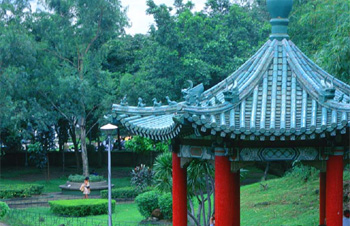Elements of Chinese Gardens

Viewing a Chinese garden frequently means looking at an ancient view of the world. Consider the lovely landscapes painted on scrolls from long ago dynasties; consider the traditions and customs that lingered in China’s countryside gardens for centuries and you begin to understand the history lies bound in the rural provinces but also in the small courtyard gardens of the cities where the mysteries of fengshui are still practiced. The following article discusses many aspects of today’s Chinese gardens with an eye toward their ancient past; the subsequent text also demonstrates how today’s landscapers and gardeners can incorporate these Oriental elements into their own gardens.
One view of Chinese gardens is to see them as a series of courtyard gardens or sections that resemble mazes or labyrinths. Instead of a whole composition, a Chinese landscape seems more like a collection of outdoor rooms that weave into and around one another. A common design is one that leads visitors along a meandering path into more complex garden spots. For example a bare entrance might lead into a small courtyard beset with one or two ornamental trees; as you move further into the garden, rocks, water features and more abundant plantings can be seen.
Most traditional Chinese gardens feature structures where calligraphy or reading could take place. These open-air rooms or small garden pavilions could look out into the landscape where the beauty of the garden could be easily admired. When incorporating such structures in the western world, opt for simple structures like arbor-seats and plain pergolas. Gazebos come in many styles but you will want to avoid ornately western models and try to come as close to an Oriental pavilion style as possible. This is not so difficult today as Oriental style gardens have grown in popularity.
Because Chinese gardens are installed in separate sections, dividers are necessary and in China these tend to be walls. Earthen walls covered with plaster and painted white are common, but rock walls and bamboo fences could be employed to great effect as well. If you are not able to provide such features for your landscape, consider using plantings to act as dividers-some hedges, a grouping of trees, or a series of trellises bedecked with typical Oriental climbers would also suffice.
Once can hardly imagine any Oriental garden without water trickling, cascading or pooling in a section of the landscape. Water features are a must, but you can adapt them to your setting easily with the wide range of pond construction materials and fountains that are available online or at your local garden center. Always choose the most naturalistic designs when it comes to fountains. Also, a simple cascade that leads into a pool of goldfish is a typical scene in a Chinese garden. Or, consider any of the three hundred varieties of Chinese waterlilies to grow in your pond. Some types of these showy flowers will even grow in a shallow dish of water.
A lake or stream on your property can easily be given a Chinese makeover with a few touches here and there. For example, consider spanning a section of water with an Oriental bridge carved from stone or constructed with wood painted black or red and heavily lacquered. Steer away from lawns to rim your pond; the Chinese associate grassland with the northern steppes from whence bands of barbarian tribes plagued them throughout the ages. Choose ornamental grasses that are native to the Far East. Also, Chinese lanterns and Oriental seating arrangements can also transform this area of your garden to reflect eastern aesthetics.
For very small gardens, consider dwarf plantings in Chinese-style containers. A miniature Chinese garden can be accomplished even on a small patio. Training trunks to bend in the Oriental style demonstrates the effect of wind transforming the natural landscape. Pruning these small trees, shrubs and plants provides a graceful windswept look that reminds one of Chinese coastal gardens.
When planning your Chinese garden it will also prove beneficial to consult fengshui references to attain a traditional style for you landscape. Designing according to fengshui principles instructs gardeners to assess wind and water. To put it simply, good natural forces can be felt running through flowing water; adding height to a landscape is also an important fengshui element. Consequently, one area of the garden may feature a running stream while the opposite side might feature a sloping terrace garden that provides a view of the whole garden.
There are many design elements to consider when it comes to individual Chinese gardens. Immerse yourself in Chinese art and landscapes either online or from books. Much as been documented about China’s imperial gardens and these can be a wonderful source of ideas when it comes to choosing ornaments and laying out your garden’s design. From pagoda style structures and fountains to stone dragons and walls there is a wealth of selections to consider for today’s gardens. As many Chinese plants can be grown in the west, there will also be a wide range of flora to consider too.